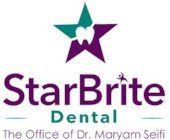Dental Bridges
Some benefits of a dental bridge
A bridge of artificial teeth, most often made of porcelain, can certainly be helpful in restoring an attractive smile, but there are other benefits to them, as well:
What Patients Are Saying About StarBrite Dental
Various types of dental bridges
What a Dental Bridge Procedure Is Like
"The entire staff seems to be there for one reason and one reason only and that is to make sure my dental needs are addressed. I am so thankful to Dr Seifi for helping me . I generally really dislike dentists She and her staff have changed my viewpoint on oral health.
- Richard R.
★★★★★
Read More About Dental Bridges in Our Blogs
Contact Us to Schedule an Appointment Today!
*We DO NOT ACCEPT HMO Insurance, State Insurance, Medicaid/Medicare, or discount plans. Fees apply for services. and same-day appts/emergencies.
Evening and Weekend Hours Available
- Monday
- Closed
- Tuesday
- -
- Wed, Fri
- -
- Thursday
- -
- Saturday
- -
- Sunday
- Closed
Office
(301) 770-1070
Fax (301) 770-0544
5936 Hubbard Dr, Rockville, MD 20852





